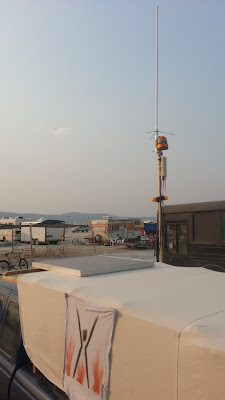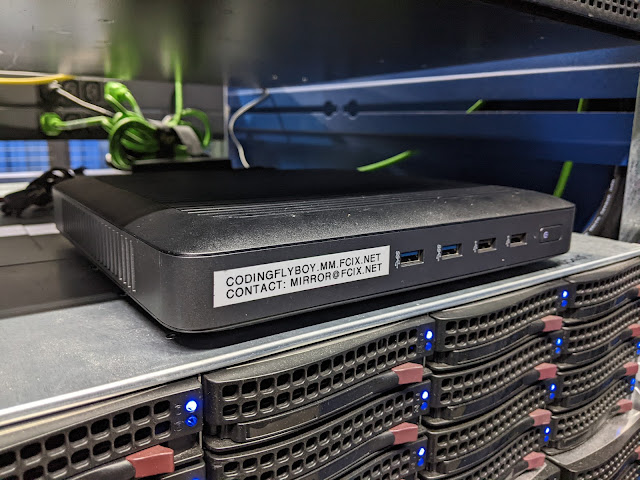How to Have Electricity and Internet at Burning Man
And Still Feel Good About It
As I mentioned in my previous Burning Man post, my big project for Burning Man was trying to get our camp solar-based electricity and Internet for the week. Considering that we had no idea what we were getting ourselves into, and that we weren't willing to bring a gas generator, both projects went surprisingly smooth with only a few little hang-ups along the way.The electrical system was built around a "TSMT-20A" solar charge controller, which I got on eBay for $21. Solar charge controllers are the glue between a solar panel, a battery bank, and a load, that opens and closes switches to try and prevent the battery bank from being damaged. This controller also happens to have "lighting" modes, where it uses the solar panel as a light sensor and is smart enough to turn the load on when the sun sets, and then turn it off again X number of hours later. Since we were running more than just outdoor lights off of our electrical system, I put the controller in "regular controller" mode and moved on with life.
The controller is important because batteries are temperamental beasts. Feed them too much energy, and they boil off water and damage themselves. Drain too much energy out of them, and they grow sulfate crystals, shed plate sponge material, and damage themselves. This means the charge controller has two jobs; disconnect the solar panel from the battery bank in the afternoon when the system is fully charged, and disconnect the load in the middle of the night when the battery bank is fully drained.
When you pay $21 for a charge controller, you don't get one with any of the extra tricks like maximum power point tracking (MPPT), where they try and change the impedance of the load on the solar panels to try and eak out a little more energy throughout the day by moving the fixed voltage load (the battery) to a more optimal point on the panel's IV curve. We were ok with this, since we designed our camp's power budget accounting for a poor level of efficiency between the panels and our camp's loads.
The battery bank we used was a pair of old Trojan-105 220Ah 6V batteries that were gifted to me for helping rebuild the scissor lift they came out of. These batteries hadn't been well taken care of, and are by most metrics on their last legs. The internal resistance of the bank is grossly high, which means you can't draw any significant current out of them (which is exactly what you need in a scissor lift), but most of their capacity is still there. This is perfect for my uses for them, since our loads are low and slow.
The solar panel is a relatively small 100W 20V panel that we borrowed from the alternative energy lab at Cal Poly.
Being amateur radio operators, most of our electrical loads are already 12VDC, which meant that we could simply plug them straight into the output of the controller (radios, lights, the WiFi AP, etc). For the rest of our devices, we needed some way to convert the 12VDC into what we needed. For 5V USB charging, I brought my USB power strip, and for 120VAC loads we brought a 400W inverter.
The picture above shows the system mostly assembled, which was done on-site. I hadn't been sure how I wanted to route everything, so while back in civilization, I went to town with a drill press and drilled a ton of random holes, even though I only ended up using a quarter of them for routing and cable control. The DC distribution from the controller to all the loads was done with Anderson PowerPoles, which is the standard 12VDC power connectors used for amateur radio.
Once put together, the system worked great for keeping all our electronics charged and running our camp lights. We were rolling in power all week; we never ran out of power during the night, and the battery bank was usually fully recharged by noon or early afternoon. We even started leaving a power strip out in the middle of our camp so any passers-by could charge their devices. Nothing in the picture above is ours; we left out the power strip when we were leaving for dinner, and came back to it filled with other people's dead electronics.
I had been a little worried about going into Burning Man depending on an untested $21 Chinese charge controller, but in the end it worked like a champ. Once we came home, I finally bothered to pop it open, and was even more impressed with the device's construction.
- The battery is fused with a 25A ATM auto fuse soldered onto the board. Probably the cheapest 25A fuses you can get, and one I happen to keep in stock for my truck.
- The power FETs on the back used gap filler to thermally couple them to the metal back plate of the controller. They are cheap unmarked FETs, but it's clearly viable to upgrade the controller with another three FETs in parallel with those that come stock.
- The controller is an ATMega48! I didn't bother tracing it out, but I'd bet the test points at the top of the board is the ISP bus for reprogramming the device. I didn't have any complaints with the stock firmware, but it doesn't get much easier than this to be able to write your own custom charge controller firmware to run on this. A project for someone with more free time than me, I'm afraid.
Black Rock City Internet
Needless to say, getting Internet into our camp was slightly more challenging than providing electricity. Black Rock City does have a microwave link network out of the city to civilization, which is piped out to the center camps at 3, 6, and 9 o'clock as open access points. We had hoped to get closer to one of these camps to make our job easier, but we still managed to make it work out at 8:30 and K.
Even having Internet at all is a debatable subject at Burning Man, but it was something we wanted to have and make available for others around us. Some burners may be able or willing to pack up and ride off into the desert for a week with no outside contact, but many of us power nerds aren't willing to leave matters like our personal businesses, websites, and important mailing lists to their own for that long. If a minimal Internet connection is the difference between smart people coming to Burning Man or not, it's a cultural shift that burners are going to need to come to terms with.
What we did was bring a Ubiquiti NanoStation, which has an internal 10dBi gain antenna that we aimed at the nearest open camp access point. Since Nanostations are based on Atheros WiFi chipsets, and we had ours running OpenWRT, we were able to configure two wireless networks on the single radio; the first as a client to the remote access point, and a second re-serving it locally as "TheCoveredWagon."
The key with trying to re-serve remote APs like this is that WiFi client mode in OpenWRT generally works best when the WiFi network is its own network interface, and not part of an interface bridge, due to the problem that bridging a WiFi client interface with Ethernet interfaces requires MAC address translation (not to be confused with IP NAT, which is similar but much more widely used). This means that you then need to route between the client WiFi interface and your local interface, which we did using the standard WAN/LAN firewall rules and a local DHCP server.
We also had the issue that the local AP must be on the same channel as the client connection to the remote network, which means that you can't set a channel for the local AP, which means that it goes down when the remote connection disappears. This meant that every time a remote AP went down, we couldn't pick a new one from our phones or my MacBook Air, but had to instead get out a laptop with Ethernet, plug it into the router, and log in from there.
The Internet was spotty all week, and even when it worked, it was slow (we're talking 2-20kBps slow), but it was enough to be usable for us to keep up with email during BM, and since we were re-serving it as an open access point, we saw ~60 other devices connect and use our Internet connection as well. Running a traceroute and ping from our network to Google was somewhere between entertaining and depressing:
Speaking with the guy in charge of all the municipal BRC microwave links, he said that if we bring 5GHz gear, we're welcome to tie into the city distribution backbone to make being our own ISP for BRC easier next year. Another one of those appealing "city life" projects that I'd love to be more involved with the next time I attend Burning Man.









